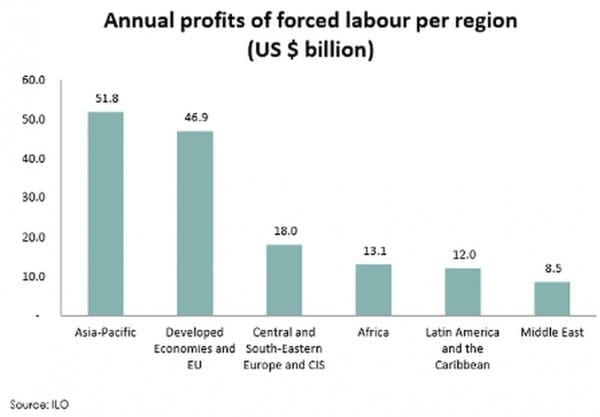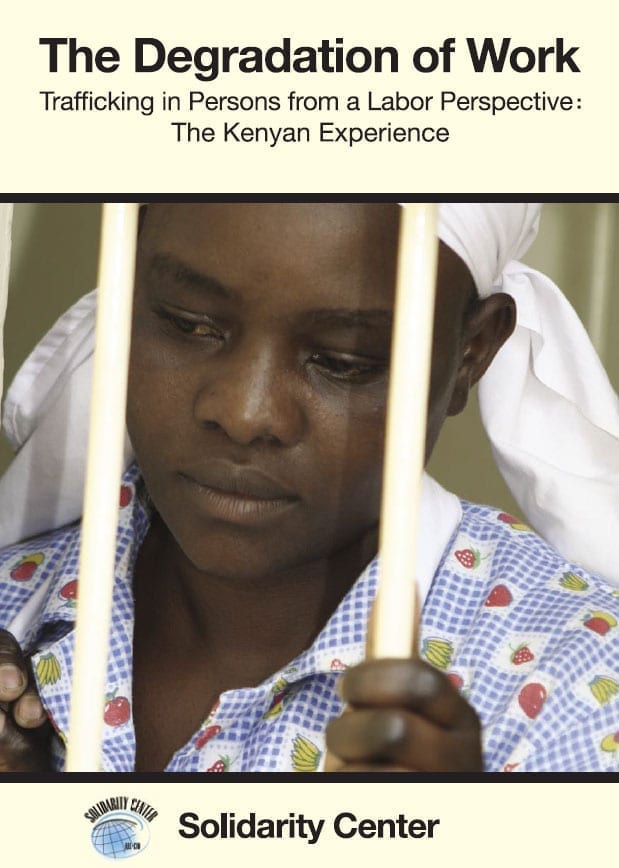May 21, 2014

Some 21 million women, men and children are in forced labor, trafficked, held in debt bondage or work in slave-like conditions worldwide, and their toil generates an estimated $150 billion in illegal profits in the private global economy, according to a new report by the International Labor Organization (ILO). The $150 billion in illegal profits is three times more than the previous ILO estimate.
he majority of those in forced labor are women and girls, who make up 55 percent of the total, compared with 9.5 million (45 percent) men and boys. Many of these women are domestic workers. Of the 52.6 million domestic workers worldwide, the report estimates 3.4 million—6.5 percent—are in forced labor. Further, many domestic workers are migrants, often exploited by labor brokers and employers. The report notes that an estimated $8 billion is literally stolen annually from domestic workers in forced labor who, on average, are effectively deprived of 60 percent of their wages.
Overall, $51 billion of the estimated $150 billion in illegal profits results from forced economic exploitation, including domestic work and agriculture, areas where women make up much or most of the workforce. Commercial sexual exploitation accounts for $99 billion.
“Profits and Poverty: The Economics of Forced Labor” finds solid evidence for a correlation between forced labor and poverty. In countries where the ILO measured “income shocks” and food insecurity, such as Niger and Bolivia, a larger percentage of forced laborers than people who worked freely came from households where income had declined. In Nepal, only 9 percent of workers in forced labor had lived in food-secure households, compared with 56 percent of freely employed individuals.
The report finds the profit from forced labor is generated from three broad areas:
• $34 billion in construction, manufacturing, mining and utilities.
• $9 billion in agriculture, including forestry and fishing.
• $8 billion saved by private households by not paying or underpaying domestic workers held in forced labor.
An individual is considered to be working in forced labor, according to the ILO’s survey guidelines, if his or her recruitment was not free and involved some form of penalty at the time of recruitment, and if that individual works and lives under duress, and faces any penalty or cannot leave the employer because of the menace of a penalty.
• Read a summary of the report.
• Read the full report.
• In this video, ILO Director General Guy Ryder urges immediate action to end forced labor.
Jan 4, 2013
Thai police will now be equipped with a detailed manual helping them identify and address human trafficking, a growing crime in many countries that involves forced labor or sexual exploitation. The Solidarity Center provided technical and financial support to the Human Rights and Development Foundation (HRDF) for the project. The HRDF then engaged in a series of lengthy consultations with a range of Thai government agencies and non-governmental organizations (NGOs) to compile the 346-page guidebook.
Pol Gen Chatchawal Suksomjit, an adviser to the Royal Thai Police, said the U.S. State Department’s annual report on human trafficking “has become a wake-up call to improve efficiency of the Thai law enforcement agencies,” with the anti-trafficking manual for police part of the government’s efforts to address this crime, which undermines the most basic human rights.
For the past three years, Thailand has been on the State Department’s Tier 2 human trafficking “watch list,” which in part means that the absolute number of victims of severe forms of trafficking is “very significant or is significantly increasing.”
In the department’s 2012 Trafficking in Persons Report, Thailand is described as “a source, destination and transit country for men, women and children subjected to forced labor” trafficking. Victims from neighboring countries, as well as from China, Vietnam, Russia, Uzbekistan and Fiji, migrate to Thailand for various reasons including to flee conditions of poverty. The bulk of migrant workers arrive from Burma.
Pol Gen Chatchawal has asked police nationwide to provide specific information to help systematically map potential trafficking sites.
In 2008, Thailand passed an anti-trafficking in persons act, and HRDF secretary Somchai Homlaor called on Thai police to be aware of the human rights aspect.
Globally, there are more than 21 million people in forced labor, including victims of trafficking, according to the International Labor Organization (ILO). The Asia-Pacific region accounts for the largest number of forced laborers in the world—11.7 million (56 percent) of the global total, according to the ILO. Africa is next at 3.7 million (18 percent), and Latin America with 1.8 million victims (9 percent).
The Solidarity Center works globally to eliminate all forms of worker exploitation and to build support for worker rights in partnership with trade unions, governments, and civil society to create community and workplace-based safe migration and counter-trafficking strategies that emphasize prevention, prosecution and protection.

Feb 24, 2007
Trafficking in Persons from a Labor Perspective: The Kenyan Experience provides readers with a general overview of human trafficking in persons from a labor perspective, with a focus on universal and global themes as illustrated by the experiences in Kenya. The country is a source, transit and destination for women, men and children trafficked for forced labor and commercial sexual exploitation.
Download here.


